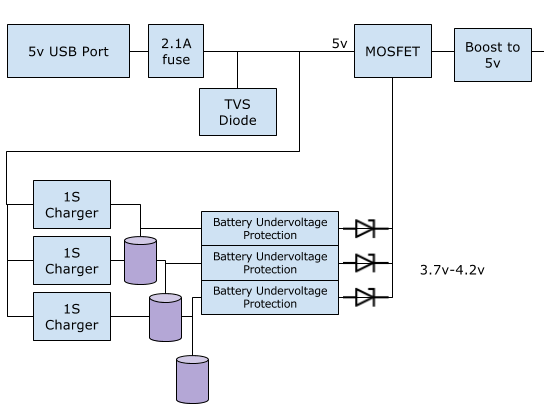Other Parts Discussed in Thread: BQ21040, , BQ28Z610
The idea is to make a battery setup in such a way that the user can use 1 or 2 or 3 18650 Lithium cells. The circuit would draw power via USB to charge the setup as well as run the application circuit after the boost section. The load is around 500mAh.
An p-Channel mosfet is used to act as a switch for the final output. USB-5v is connected to the gate of the mosfet, the output of the UV protection circuit is connected in parallel to the drain of the mosfet. So as soon as USB is shut off, the circuit would draw power from the battery pack that is connected. Circuit referencefrom ESE answer.
The main reason to use the setup was to allow the user to use 1S by default. If the lifetime of the application circuit was to be extended, the user attached another 1S to the setup. So the boost section ( 3.7v-4.2v to 5v) remains the same.
Questions
- Is it safe to use 3 separate charging ICs and 3 separate 1S battery protection ICs to charge 3 separate Li+ batteries?
- Is is safe to draw power by connecting the output of the protection circuits in parallel (after the diodes)?
Charging IC choice : bq21040
Protection IC choice : BQ2973
For safety reasons I'd like to consume the battery only till 3.4v. ( so the working range would be from 3.4v - 4.2v).
Now, if more than 1 batteries are connected as above, how would anyone stop 1 battery from going below 3.4v?
Eg Bat 1 : 4.1v, Bat 2: 3.8v
- Would they both drain together? Or would bat2 drain first/faster and then Bat1 start draining?
We are planning to keep the charging current at 500mAh. So at any given point int time, we'd be drawing 2000mAh from a USB port.
- If this is plugged to a laptop USB port and the port allows only 500mAh to be drawn, is there a chance of anything going bad?





